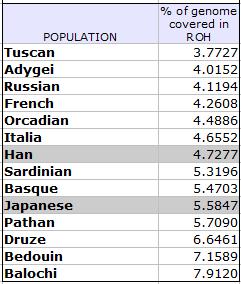from a paper by manuel eisner entitled “Modernization, Self‐Control and Lethal Violence” about how the homicide rate has been steadily dropping in europe since at least the middle ages:
“[T]he data suggest that the secular trajectories of low homicide rates differ among large geographic areas. It appears that English homicide rates were already considerably lower in the late sixteenth century than during the late Middle Ages and that they declined continuously along a log-linear trend over several centuries. Extant estimates for the Netherlands and Belgium suggest a very similar structure trend in these areas. In the Scandinavian countries, the transistion to the decreasing trend occurs notably later, namely in the first decades after 1600. Despite huge gaps in the data, the German-speaking areas may also be assumed to have joined the declining trend from the early seventeenth century onwards. For Italy, however, all the available data indicate that acts of individual-level lethal violence remained very frequent until the early nineteenth century. It is not until the mid-nineteenth century that the rate begins to decline, but then very steeply.”
hmmmm. now where have i heard a pattern like this before? england, the netherlands, germans earliest in something … scandinavians later … italians last. (~_^)
let’s look at eisner’s charts first (logarithmic scales):
england
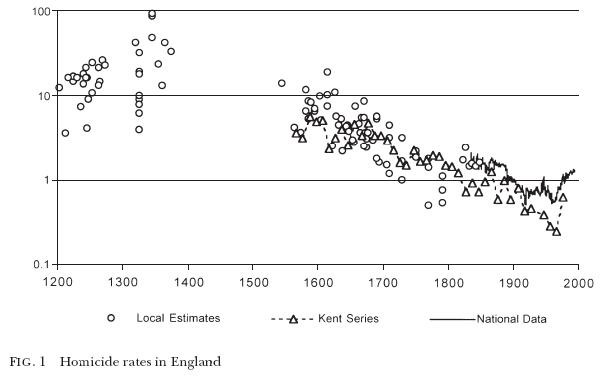
“In the thirteenth and fourteenth century, the mean of almost 40 different estimates lies around 24 homicides per 100,000. The average homicide rates are higher for the late fourteenth century than for the thirteenth century, but it seems impossible to say whether this is due to the difference of the sources used or reflects a real increase related to the social and economic crises in the late Middle Ages. When estimate start again after a gap of some 150 years, the average calculated homicide rates are considerably lower with typical values of between 3-9 per 100,000. From then onwards, the data for Kent line up with surprising precision along a straight line that implies a long-term declining trend for more than 350 years.” [pg. 622]
begium/netherlands
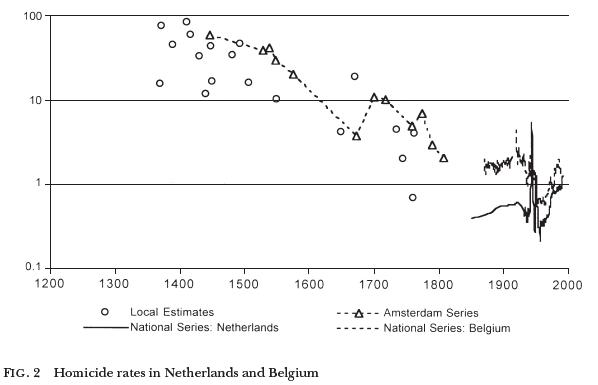
“When plotted on a graph, the respective secular trends are very similar to those found for England. During the fourteenth and early fifteenth centuries, counts of murder and manslaughter cases in cities like Antwerp, Leuwen, Utrecht or Amsterdam consistently result in estimated homicide rates of between 30 and 60 cases per 100,000. Spierenburg presents a series of estimates for Amsterdam between the sixteenth and the early nineteenth centuries based on autopsy reports. He finds somewhat lower levels of about 20 per 100,000 in sixteenth-century Amsterdam…. Seventeenth-century homicide rates in both Amsterdam and Brussels are considerably lower and range between four and 11 per 100,000.” [pg. 623]
germany/switzerland
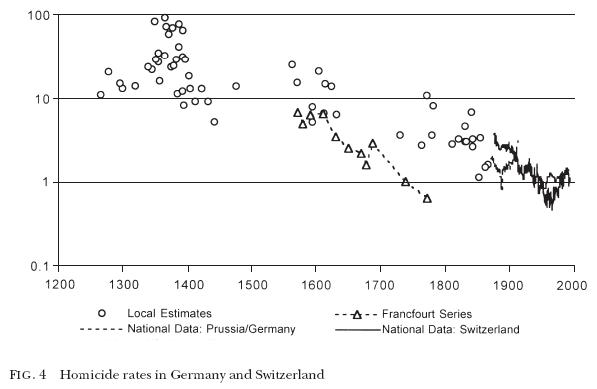
“In total, I found more than 30 estimates referring to various cities in the thirteenth and fourteenth century. They range between approximately eight and 80 homicides per 100,000, with an overall mean of 35…. Schwerhoff and Eibach present homicide rates based on convictions in the city of Francfourt am Main between the sixteenth and the late eighteenth centuries. A cluster of estimates around 1600 yields an average homicide rate of about 10 per 100,000.” [pg. 625]
scandinavia
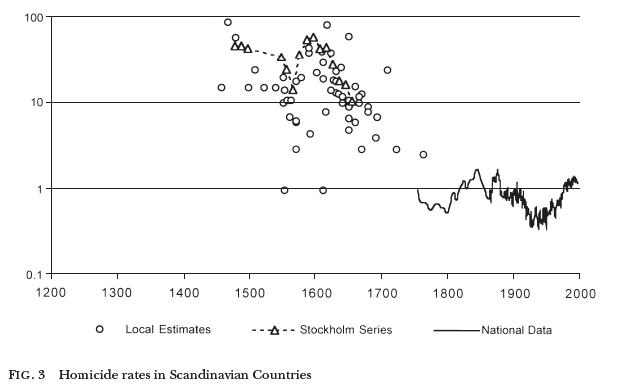
“[The figure] suggests first that homicide rates typically ranged from 10 to 60 cases per 100,000 between the mid-fifteenth and the mid-seventeenth centuries and that the average rate may have been at about 25. Strikingly, the Scandinavian evidence shows no sign of declining homicide rates until about 1600. Yet by 1740, when the first Swedish national vital statistics are available, homicide rates are already below 1 per 100,000. The data thus suggest a spectacular decline of lethal personal violence by a factor of at least 10:1 within a period of only 150 years.” [pg. 624]
(just how fast can selection for certain traits happen?)
italy
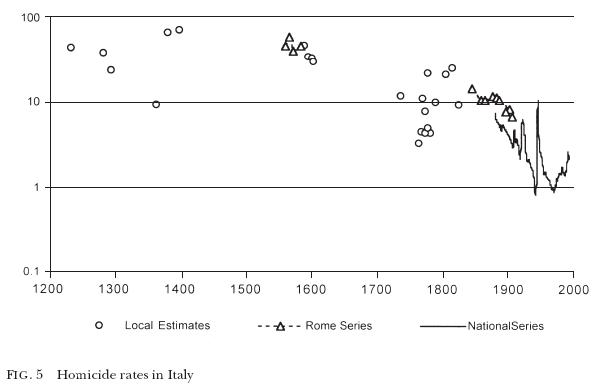
“The secular pattern in Italy … diverges decisively from the trend found for norther Europe. There exist isolated estimates for a number of Italian cities, such as Bologna, Florence, Mantova and Venice, whereby Florence shows the absolute highest homicide rate with 150 homicides per population of 100,000 in the fourteenth century. Blastenbrei provides homicide rates of 30 to 80 per 100,000 for Rome in the sixteenth century…. [T]he exant estimates do indicate that for a long period between the high Middle Ages and the seventeenth century in Italy, there was a slight decline in the frequency of homicides. However, Italy may be a particularly problematic case because of the vast differences between different areas. For example, Doneddu gives a homicide rate of 22 for late eighteenth-century Sardegna, while the data presented by Sardi for the duchy of Tuscany yield a rate of 4-5 per 100,000. Starting from 1881 … [t]he rate begins at about 8 per 100,000 and then — with the exception of higher rates during the final years of both world wars — falls steeply up to the mid 1960s.” [pgs. 626-27]
furthermore: “Durkheim showed that in the late nineteenth century an arc of high murder rates ranging from Ireland over Spain, Italy, Austria, and Hungary encircled a zone of low homicide rates.” [pg. 631]
_____
eisner comes a hair’s breadth away from a good sociobiological explanation for why all of this happened, but he missed it (prolly ’cause he’s a criminologist and not a biologist — not that there’s anything wrong with that!):
“[T]he work of Norbert Elias probably forms the most prominent theoretical framework discussed by those historians of crime who are interested in explaining this long-term trend. Elias’s well-known theoretical model of the ‘civilizing process’ embraces long-term social dynamics at a macro level as well as changes in typical psychological traits and the developments in characteristic modes of behaviour. In a nutshell, the theory of the civilizing process holds that over a period of several centuries a type of personality has come to prevail that is characterized by increasing affect control, decreasing impulsivity, and a rationalized manner of living — in brief: high levels of self-control. Higher levels of self-control imply, in turn, the gradual pacification of everyday interactions, which becomes manifest by lower levels of violent behaviour…. [pg. 619]
all of these traits, like impulse control (deferred gratification), are undoubtedly at least partly rooted in our natures. i think it’s likely that what happened over time in europe (and elsewhere?) is that greater impulse control, etc., etc., was selected for in the population — but i’m a reductionist (hey, i’m in good company!), so you knew i’d say that. (~_^)
eisner offers up one of the standard explanations for the decrease of violence over time and that’s the role of the state. the state took over as the executor of revenge (we call it justice now) so individuals/families no longer had to mete it out — AND the state really, really discouraged violence in general — if you were violent, you’d go to jail or maybe be executed. i think the idea that the state has played a big role in the reduction of violence over time makes a lot sense, ’cause these things that the state started doing sure sound like selection pressures — clearly the second one is especially if you execute violent criminals. you just take them and all their personality traits right out of the gene pool, no?
but eisner also mentions an idea of émile durkheim‘s related to the reduction of violence that’s right up my alley:
“Durkheim saw the decline of homicide rates as resulting from the liberation of the individual from collective bonds rather than as the consequence of the coercive potential of the state. High levels of lethal violence thus mirror the intensity of ‘collective emotions’, which bind the individuals to ‘groups of things that symbolically represent these groups’. Violence thus declines to the degree that the person becomes liberated from its sacred obligation to the group, and the rise of moral individualism….”
“This is in accordance with a society in which ‘honour’ constitutes highly important social capital of the male person as a representative of his group…. Such a theoretical framework may help to better understand why the secular decline in homicide rates primarily seems to have been due to a decrease in male-to-male fights. And it may also offer a point of departure for understanding the high violence rates in Italy, where a culture of honour persisted despite the early development of administrative and judicial structures in the city states.” [pg. 632]
yes! but, again, what’s missing is the biology of it.
the individual in (parts of) europe was liberated from the “collective bonds” because europeans started outbreeding in the early medieval period and, over the subsequent generations, the frequencies and perhaps even types of altruism genes changed in the populations. europeans quit behaving like inbred pashtuns who are always looking for revenge when their familiy’s honor is tainted because they (the europeans) were no longer inbred.
england, the netherlands, belgium, germany and switzerland saw the earliest reduction of violence because they were the european populations who started outbreeding the earliest (in some cases, as early as the 500s). the scandinavians — the swedes and the norwegians, anyway — probably didn’t start outbreeding until sometime after ca. 1000 a.d. when they converted to christianity. that could amount to nearly 500 years less outbreeding compared to the franks and the english, and their reduction in crime was a few hundred years later as well.
populations on the periphery — the irish, the spanish, the italians, the hungarians — all continued to be much more violent than “core” europe for a much longer time AND they also all kept inbreeding in one form or another longer than the germans or the english. and the italians? — differences between the north and south, again! — the south being more violent than the north.
i know, i know. i start to sound like a certain individual (won’t mention any names!) who has only one explanation for everything. i don’t think inbreeding/oubreeding and altruism explains everything. REALLY! but i do think it applies in this case. it’s not the entire explanation (i think the role of the state is important, too, for instance) — and there’s more to it than just how much inbreeding/outbreeding there is. like greying wanderer said:
“i think there’s likely to be a compounding effect too. as the clannishness recedes it becomes easier – and in fact neccessary as the only previous rule of law was clan vendetta – to institute a communal rule of law instead.”
absolutely! with all of the outbreeding, european societies became more “corporate” simply because the old extended-family/clan/tribal ties disappeared. everything had to be arranged differently. but europeans — northwestern europeans more than others — also just felt differently about the world and their place in it and their relationships with others than their ancestors had. ’cause they were different.
_____
h/t to halvorson for pointing out a post by agnostic on this paper from a couple of years ago @gnxp. thnx, halvorson!
(yes, i’ve got pinker’s new book sitting and waiting for me on my kindle. and i am planning on reading it. any day now…. (~_^) )
(note: comments do not require an email. justice?)
